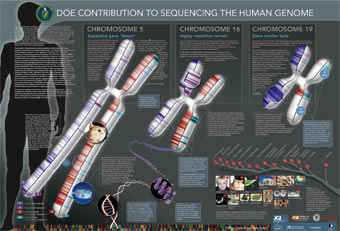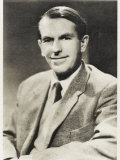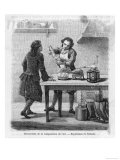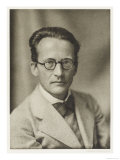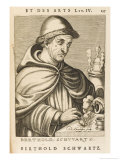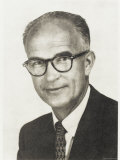|
|
|
|
|
|
|
|
|
|
|
|
SCIENCE:
PHYSICS & CHEMISTRY
|
|
|
|
|
|
|
|
|
|
|
|
|
|
|
|
|
|
|
 |
|
|
|
|
|
|
|
|
|
|
|
|
Frederick Sanger
b. 8-13-1918; Rendcomb, England
d. 11-19-2013; Cambridge
Biochemist Frederick Sanger was awarded the Nobel Prize in Chemistry in 1958 and 1980 for work with DNA. Sanger was the fourth person to be awarded two Nobel Prizes (others Marie Curie, Linus Pauling and John Bardeen).
Sanger, who was raised in a Quaker home, was a pacifist and signed the Peace Pledge Union “I renounce war, and am therefore determined not to support any kind of war. I am also determined to work for the removal of all causes of war.”
• Selected Papers of Frederick Sanger
|
|
|
|
Carl Wilhelm Scheele
b. 12-9-1742; Stralsund, Swedish Pomerania, today Germany
d. 5-21-1786; Koping, Sweden
Carl Wilhelm Scheele, the son of a carpenter, and without a formal science education, became a pharmacist. Scheele read many books and was an experimenter. Scheele, Priestley and Lavoisier all “discovered” oxygen about the same time.
Scheele also died at a young age, probably due to his experimentation of tasting the chemicals he was studying.
• Oxygen
|
|
|
|
Erwin Schrödinger
b. 8-12-1887; Vienna, Austria
d. 1-4-1961
Schrödinger was awarded the Nobel Prize for physics in 1933 (with Dirac) for his Schrödinger equation describing the space and time dependence of quantum mechanical systems. In 1935, he proposed the Schrödinger's cat thought experiment.
• What is Life? by Erwin Schrodinger
|
|
|
|
|
|
|
Glenn T. Seaborg
b. 4-19-1912; Ishpeming, MI (raised in California)
d. 2-25-1999; Stanford, CA
Glenn T. Seaborg shared the 1951 Nobel Prize in Chemistry for “discoveries in the chemistry of the transuranium elements”. He also contributed to the discovery and isolation of ten elements (plutonium, americium, curium, berkelium, californium, einsteinium, fermium, mendelevium, nobelium and element 106, which was named seaborgium in his honor while he was still living), and developed the actinide concept, which led to the current arrangement of the actinide series in the periodic table of the elements.
Seaborg was also a noted author and educator as well as the second chancellor of the University of California, Berkeley.
Glenn T. Seaborg quotes ~
• “There is a beauty in discovery. There is mathematics in music, a kinship of science and poetry in the description of nature, and exquisite form in a molecule. Attempts to place different disciplines in different camps are revealed as artificial in the face of the unity of knowledge. All literate men are sustained by the philosopher, the historian, the political analyst, the economist, the scientist, the poet, the artisan and the musician.”
• “One of the first laws against air pollution came in 1300 when King Edward I decreed the death penalty for burning of coal. At least one execution for that offense is recorded. But economics triumphed over health considerations, and air pollution became an appalling problem in England.”
• “The education of young people in science is at least as important, maybe more so, than the research itself.”
• “Our Nation is at risk. Our once unchallenged preeminence in commerce, industry, science and technological innovation is being overtaken by competitors throughout the world ... the educational foundations of our society are presently being eroded by a rising tide of mediocrity that threatens our very future as a Nation and as a people. What was unimaginable a generation ago has begun to occur -- others are matching and surpassing our educational attainments. /If an unfriendly foreign power had attempted to impose on America the mediocre educational performance that exists today, we might well have viewed it as an act of war. As it stands, we have allowed this to happen to ourselves ... We have, in effect, been committing an act of unthinking, unilateral educational disarmament.” ~ A Nation at Risk
• Adventures in the Atomic Age: From Watts to Washington
|
|
|
|
|
|
|
Benjamin Silliman
b. 8-8-1779; North Stratford, now Trumbull, Connecticut
d. 11-24-1864
Benjamin Silliman, one of the first American professors of science, was the first American to fractionate petroleum (crude oil) by distillation in 1854. He was first educated as a lawyer, then studied chemistry and geology.
|
|
|
|
Lyman Spitzer
b. 6-26-1914; Toledo, OH
d. 3-31-1997; Princeton, NJ
Theoretical physicist and astronomer Lyman Spitzer is best remembered for conceiving the idea of telescopes operating in outer space as well as research in star formation and plasma physics. He also worked on the development of sonar during WWII, and later as director of the Princeton University Observatory.
He was honored for his work with the naming of the Spitzer Space Telescope, one of NASA's Four Great Observatories project (Hubble Telescope, Compton Gamma Ray Observatory and the Chandra X-ray Observatory).
Spitzer was also an avid mountain climber and music lover.
|
|
|
|
Leo Szilard
b. 2-11-1898; Budapest, Hungary
d. 5-30-1964; La Jolla, CA
Physicist Leo Szilard “conceived the nuclear chain reaction in 1933, patented the idea of a nuclear reactor with Enrico Fermi, and in late 1939 wrote the letter for Albert Einstein's signature that resulted in the Manhattan Project that built the atomic bomb.”
|
|
|
previous page | top | next
Famous Chemist & Physicists List | a | b | c | d-e | f | g | h | i-j-k | l | m | n-o | p | q-r | S | t | u-z
|
|
I have searched the web for visual, text, and manipulative curriculum support materials - teaching posters, art prints, maps, charts, calendars, books and educational toys featuring famous people, places and events - to help teachers optimize their valuable time and budget.
Browsing the subject areas at NetPosterWorks.com is a learning experience where educators can plan context rich environments while comparing prices, special discounts, framing options and shipping from educational resources.
Thank you for starting your search for inspirational, motivational, and educational posters and learning materials at NetPosterWorks.com. If you need help please contact us.
|
|
|


